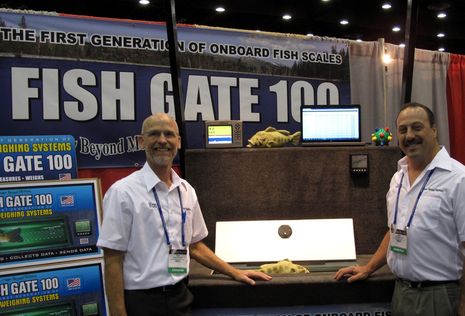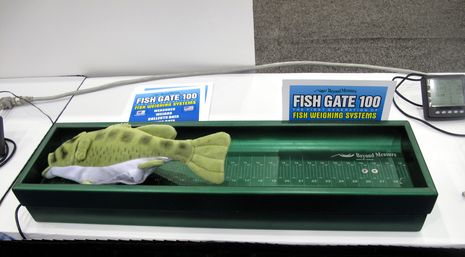Fish Gate 100, the IBEX launch
I got such a kick out of these guys. Not only did they come to IBEX with an exceptionally innovative new product, but they seemed to confirm a couple of my pet theories. One is that even a tiny startup company still has a chance in the marine electronics industry. And the other — which is definitely related — is that NMEA 2000 can make it easier to develop new products which are usefully unique while still leveraging off and/or integrating with, existing systems…
In fact, I was wandering around the large horseshoe of tables that was NMEA 2000 Connect-Fest IBEX 2011 when I first spotted the Fish Gate 100. Hello, a fish scale connected to a backbone of navigation and systems sensors and displays?!? Yup, one trick the scale can do is to capture a fisherman’s location along with depth and water temp when he’s weighing and measuring his catch…
And the weighing is impressively precise. When I found Ron and John in their booth — “just two guys from Appleton, Wisconsin” — they showed me how the Fish Gate 100 could replicate consistent weight values even when tilted around. They also had a small weight they could pull from the fish doll’s belly that helped confirm their claim of .02 pound accuracy.
But that’s not all. Besides logging each catch — which might help any fisherman establish valuable patterns — the Fish Gate is designed to support tournaments where the prize criteria is the total weight of a contestant’s best five or so fish. Using the screen below, you can see if a fresh catch should replace one of the five fish already tagged in your live well and make that happen. And since pro fishing can get darn serious — like for bass, or crappies — the Fish Gate is also designed to send its data ashore via satellite or cellular.
So Ron and John’s initial goal is to market Fish Gate 100 — at about $2,500 retail, a pretty expensive system — to the tournaments which struggle with live coverage of their events. But the further possibilities seem pretty obvious. Given that they’ve developed the precision hardware and the underlying software — and even, I think, a missing PGN for weight and length — couldn’t, say, a partner Lowrance or Humminbird MFD be programmed to do the data display and manipulation. (Yes, Humminbird now supports NMEA 2000, backward compatible too.)
Or might there eventually be an app that would let you take add a photograph and notes to Fish Gate data, and, bada-bing, put it all up on Facebook? More seriously, might not this integrated measurement system have value in research or commercial fishing, and help N2K onto those vessels? Ron and John’s new company is called Beyond Measure and, though under construction, its web site is here. Please make them welcome to the wonderful world of marine electronics.
















The combination of boat show touring and having to deal with an ad server virus (fixed!) has led to infrequent entries lately, which I regret. However, I’m stocking up stories like acorns for winter. Then again, it’s off to Fort Lauderdale next week and, hot damn, I’m also going to attend part of the America’s Cup races in San Diego. My story stash is apt to grow gigantic, but patience please.
I can certainly see the fisheries research folks wanting one of these. It’s obviously overkill for the average recreational angler, although the tournament folks who buy $1.2M boats and load them with $200k of gear and $10k of fuel will of course jump on it. But if you’re trying to put together comprehensive data on a fish population, this thing plus a bit of custom software could really speed things up- thus you get more data, and it’s less prone to data entry errors, and you can get better statistics from the results.
A problem with NMEA 2000 is that the PGNs are delineated and defined by a technical committee which moves at a glacial pace.
These guys had a cool idea. They actually built their cool idea into a product which plugs into a NMEA 2000 system. Good on ya. There are today displays which could in principle display the 3 or 4 digits plus a decimal place of information. Unfortunately, getting in the way of this is a the lack of a FISH WEIGHT PGN.
Why can’t NMEA 2000 just include some wild card number/label PGNs? In the case of N2K being used to control something, I understand the need for a committee. But in the case of display, a committee just gets in the way.
This gets worse in a world where MFDs give way to boat computers.
Chris:
Manufacturers can write their own PGNs, and most do. They have proprietary data sentences for things like autopilot control, which is why a Simrad AP24 control head cannot control a Raymarine X-10 corepack, even though they theoretically can co-exist on a single NMEA2000 network with other devices.
So implementing this doesn’t ‘require’ NMEA to issue a new PGN – just individual manufacturers to release software that will read the Fish Gate data. If say, Lowrance, writes software that can read the Fish Gate, then that gives them a leg-up on a competitors MFD.
Who this hurts most are developers of hardware like the Fish Gate guys – because their device is useless without a display.
Let me add some nuance to Aaron’s comment:
* I’m not even sure that the Fish Gate 100 transmits a weight PGN. The display may just be receiving log data from the backbone, and the scale itself may communicate with the display with an analog signal.
* But it strikes me that Beyond Measure could create more market by transmitting a weight PGN, proprietary or otherwise, right from the scale so that it could be integrated by the likes of Lowrance or Humminbird. It could make their core invention work better and be less expensive and easier to install.
Got some very interesting background info from David Morschhauser, who helped Beyond Measure with software development (and is also the proprietor of Mystic Valley Communications, the company working on the first programmable N2K bridge: http://goo.gl/2nLKI ):
1) The current fish weight is transmitted from the scale using an official NMEA 2000 PGN, which was actually approved at last February’s Standards Committee Meeting. The name reflects its more general use and application: Payload Mass, and provides the ability to transmit mass values up to 429,496.7292 kg with a resolution of 0.1 gram.
Frankly the Standards Committee made some useful suggestions that will mean that we don’t need to invent a new PGN tomorrow to weigh dredge spoils. And the actual time from first official proposal to approved PGN was only from the September 2010 to February 2011 meeting. But you _DO_ need to do your homework, and be humble enough to accept when someone has a better trap for your mouse!
2) The fish weights in the saved weights list _IS_ transmitted using a proprietary PGN. When we originally put the concept before the Standards Committee, the Standards Committee persuaded us to use a proprietary PGN as the use and format is pretty specific to exactly what John and Ron wanted their product to do, and would not be of more general use.